Ace the 2025 Ramsay MultiCraft Test: Enhance Your Proficiency with Our Practice Test & Course
- Overview
- Quiz
- Curriculum
- Reviews

Complete Ramsay MultiCraft Prep
Last Updated: Jan 22, 2025
Course Content
- 1General Skills and ConceptsBuy this Course: Get full access to all lessons, practice tests and guides.
- 2Tools, Equipments & Test InstrumentsBuy this Course: Get full access to all lessons, practice tests and guides.
- 3Electrical FundamentalsBuy this Course: Get full access to all lessons, practice tests and guides.
- 4Mechanical MaintenanceBuy this Course: Get full access to all lessons, practice tests and guides.
- 5Fluid Power, Power Transmission and DistributionBuy this Course: Get full access to all lessons, practice tests and guides.
- 6Control and ElectronicsBuy this Course: Get full access to all lessons, practice tests and guides.
- 7Automation and NetworkingBuy this Course: Get full access to all lessons, practice tests and guides.
- 8Facilities MaintenanceBuy this Course: Get full access to all lessons, practice tests and guides.
What is The Ramsay MultiCraft Test?
The Ramsay MultiCraft Test is a standardized assessment that evaluates the knowledge and skills of maintenance technicians. It covers a wide range of subjects such as mechanics, electricity, and hydraulics hence called “multi-craft”.
The test is designed to measure the candidates’ aptitude and skills across various technical disciplines, providing employers with valuable insights into applicants’ overall technical aptitude and their potential to succeed in diverse job roles.
By incorporating the Ramsay MultiCraft Test into their hiring processes, organizations have streamlined their recruitment efforts to identify candidates who demonstrate the necessary competencies and potential to excel in maintenance technician positions
Ramsay Multicraft Practice Test
Ramsay MultiCraft Test: Levels & Format
The Ramsay MultiCraft Test offers different levels of assessment to accommodate candidates at various stages of their training and experience for different job profiles. Here’s an overview:
These tests are conducted in both offline and online formats, and the format you will face depends on the specific requirements and arrangements made by your hiring organization.
Apprentice / Entry Level
This level is for candidates with limited formal training or experience in the maintenance technician field. Typically, they have 0-1 year of training and need an additional 2-3 years to develop skills fully. There are 3 different tests of different job profiles even at the entry level.
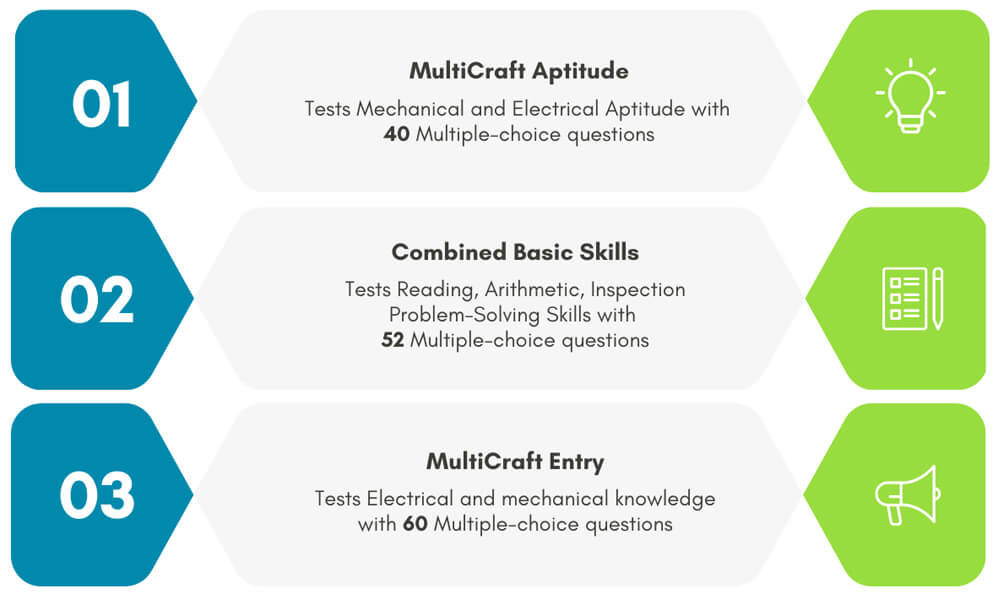
Trainee Level
Candidates at the Trainee level have accumulated 2-3 years of training in maintenance technician roles. They are in the early stages of their career and typically require an additional 1-2 years of training to further enhance their abilities. There is only one type of test for this level that measures the skills for Mechanical and electrical maintenance knowledge. It contains 60 questions in the multiple choice format.
Journey Level
The Journey level is suitable for candidates who have gained 2-5 years of training and/or experience in maintenance technician positions. At this level, candidates have developed a solid foundation of knowledge and skills and are capable of handling a range of maintenance tasks independently.
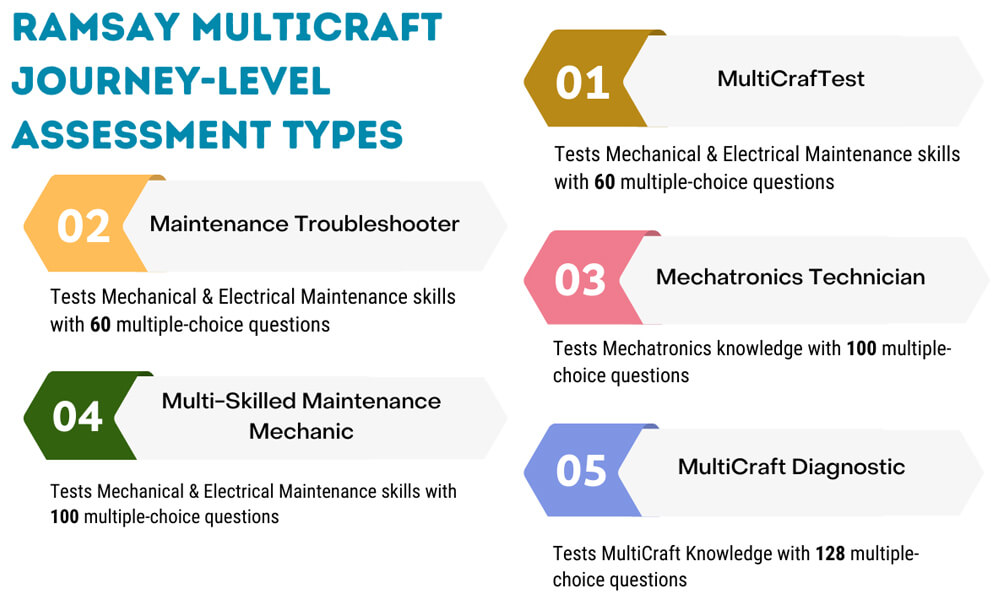
Above-Journey Level
Candidates at this level possess 5 or more years of training and/or experience in the maintenance technician field. These individuals have achieved a higher level of expertise and are often considered subject matter experts in their respective areas.
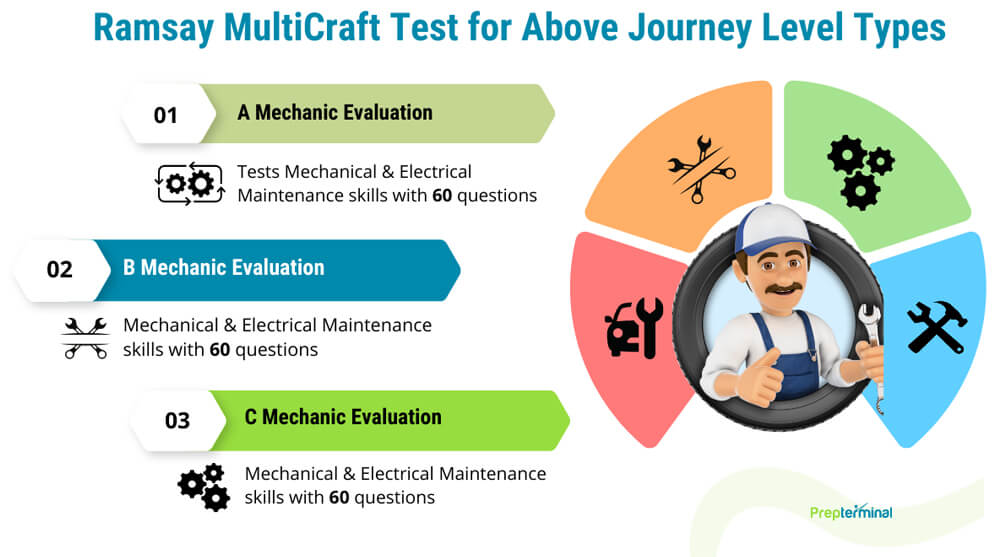
Ramsay MultiCraft Question Types
Hydraulics & Pneumatics: Questions of this type help in assessing candidates’ understanding of fluid power systems and their ability to work with hydraulic and pneumatic equipment.
Welding & Rigging: These are questions about welding techniques and safety protocols, as well as proficiency in rigging operations.
Power Transmission & Lubrication: These Questions help to test the candidates’ comprehension of power transmission systems and lubrication principles for machinery.
Mechanical Maintenance: Questions under this category help in testing knowledge and skills related to maintaining and troubleshooting mechanical components and systems.
Shop Machines, Tools & Equipment: These help in testing a person’s familiarity with various machines, tools, and equipment commonly used in maintenance tasks.
Pumps & Piping: These questions check a persons understanding of pump operation, piping systems, and related maintenance procedures.
Combustion: For evaluating knowledge of combustion processes, including combustion equipment and safety measures.
Motors: These Questions can test a person’s skills and comprehension of electric motors, including their operation, maintenance, and troubleshooting.
Control Circuits: Assessing understanding of electrical control circuits and the ability to interpret and troubleshoot them.
Schematics and Print Reading: Evaluating the ability to read and interpret technical drawings, schematics, and blueprints.
Digital Electronics: Assessing knowledge of digital electronic systems and components commonly used in maintenance tasks.
Power Supplies: Testing comprehension of power supply systems, including electrical distribution and power management.
Computers & PLCs (Programmable Logic Controllers): Evaluating familiarity with computer systems and programmable logic controllers used in maintenance applications.
Test Instruments: Assessing the ability to use and interpret readings from various test instruments and measurement tools.
Basic AC/DC Theory: Testing knowledge of electrical theory and principles related to alternating and direct current circuits.
Power Distribution: Evaluating understanding of power distribution systems and electrical panel operations.
Electrical Maintenance: Assessing knowledge and skills related to electrical maintenance tasks, including troubleshooting and repair.
Ramsay Multicraft Sample Questions
Here are some sample questions from the Ramsay Multicraft Test, along with the answers and explanations:
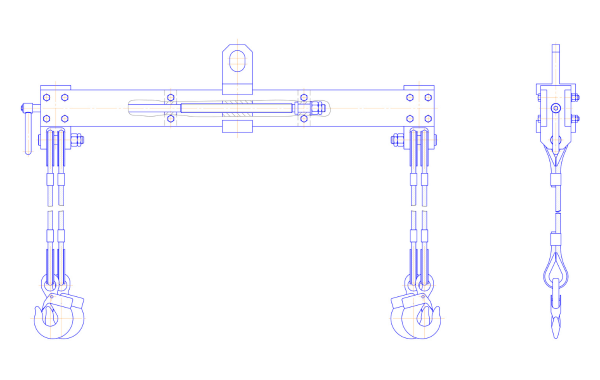
- A:
It allows for faster lifting speeds.
- B:
It provides redundant security in case of a wire rope failure.
- C:
It decreases the overall weight of the lifting mechanism.
- D:
It effectively quadruples the lifting capacity of the hoist.
Explanation:
A four-part reeved wire rope hoist involves dividing the load between four separate wire ropes. This effectively multiplies the lifting capacity of the hoist, enabling it to lift loads four times as heavy as a single-line system with the same rope and winch strength.
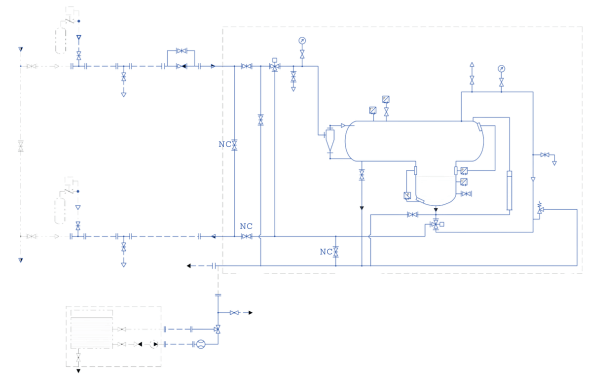
- A:
The valve is closed when the system is inactive
- B:
The valve is closed during normal operation
- C:
The valve is always closed
- D:
The valve can only be closed manually
Explanation:
A 'normally closed' valve in hydraulic schematics signifies that the valve is in the closed position during normal system operation and will open when actuated.
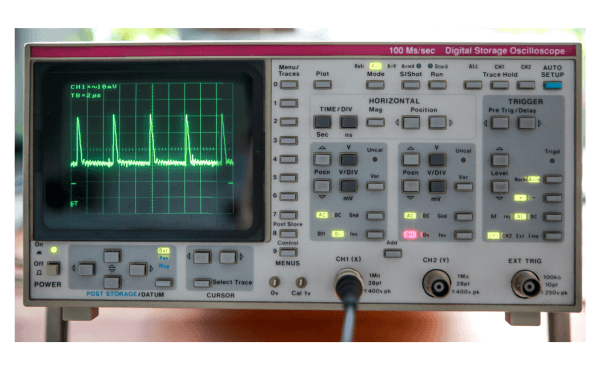
- A:
Quantization noise
- B:
DC offset error
- C:
Signal phase distortion
- D:
Aliasing
Explanation:
When using the FFT function in an oscilloscope, the primary source of error is usually quantization noise. This is the error introduced by the finite resolution of the oscilloscope's analog-to-digital converter. The ADC samples the input signal at discrete levels, which can lead to small discrepancies between the actual signal and the digitized version.
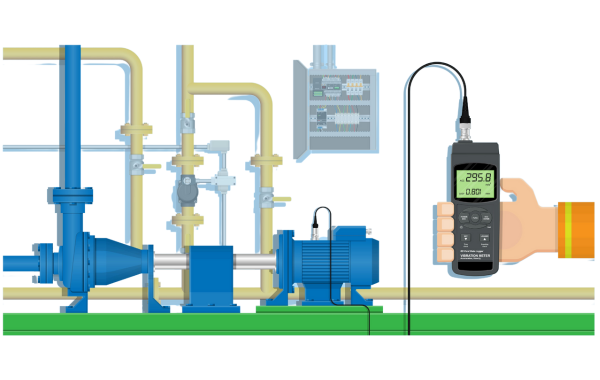
- A:
Misalignment of shafts
- B:
Bearing defects
- C:
Imbalance of the rotor
- D:
Electrical faults in motor windings
Explanation:
Vibration analysis is a powerful tool for detecting mechanical faults in rotating machinery, such as misalignment, bearing defects, and rotor imbalance. However, it's less effective in detecting electrical faults in motor windings. Techniques such as motor current signature analysis are more suitable for this purpose.
How is the Ramsay Multicraft Test Scored?
The Ramsay Test is scored in a variety of ways, depending on the specific version or customization of the test. However, the most common scoring methods are:
Raw Score: The raw score is the total number of correct answers a candidate gets on the test. Each correct answer contributes to the raw score, while incorrect or unanswered questions typically do not result in a deduction.
Scaled Score: In some cases, the raw score is converted into a scaled score to account for the difficulty level of the questions and ensure fairness across different test versions. The scaled score allows for a better comparison of candidates’ performance regardless of the specific test form they took.
Percentile Rank: The percentile rank compares a candidate’s performance to that of a norm group or reference population. It indicates the percentage of test-takers who scored lower than the individual. For example, if a candidate’s percentile rank is 75, it means they performed better than 75% of the norm group.
Performance Bands: The test results may be categorized into performance bands or levels, such as “Advanced,” “Proficient,” “Basic,” or “Needs Improvement.” These bands provide a qualitative assessment of a candidate’s performance, indicating their skill level in relation to the expectations for the specific job or industry.
It is important to note that the exact scoring methodology for the Ramsay Test can be tailored and customized based on the specific requirements and preferences of the organization or employer utilizing the assessment.
Ramsay MultiCraft Assessment: FAQs
The Ramsay MultiCraft Test can be conducted both online and offline, depending on the preferences and arrangements made by the administering organization. The organization you are taking the test for will decide what form of tests is presented to you.
The number of questions in the Ramsay MultiCraft Test may vary depending on the level and specific version of the test you are taking. Typically, the test consists of multiple-choice questions, with the number of questions ranging from 40-128, depending on the level and version of the assessment. The allotted time for completing the test will also vary but is usually within the range of one to two hours.
Yes, there are many online resources like practice tests, guides and even detailed prep courses that can help you prepare for the Ramsay multicraft test.
Candidates should focus on technical skills and knowledge relevant to maintenance technician roles. This includes mechanics, electricity, hydraulics, power transmission, troubleshooting, and practical application of maintenance concepts. Familiarity with shop machines, tools, and equipment is crucial and so is taking practice tests and understanding the basics.
The scoring criteria or benchmarks used in the Ramsay MultiCraft Test may vary depending on the organization you are taking the test for. Typically, candidates are scored based on the number of correct answers they provide in the multiple-choice format. The specific passing score or criteria for success may be determined by the employing organization.
The retake policies for the Ramsay MultiCraft Test can differ among administering organizations. Some organizations may permit candidates to retake the test after a specific duration, while others may impose restrictions or limitations on retaking the assessment based for them. It is essential to verify the retake policy with the specific organization before taking the test.
The duration for which the Ramsay MultiCraft Test results are valid, both for the intended role and other positions within the organization, is determined by the administering organization. It is crucial to inquire with the organization to ascertain the validity period of the test results and their applicability to various roles within the organization.
The skills assessed in the Ramsay MultiCraft Test have direct relevance to real-world scenarios and a wide range of job roles in the maintenance technician field. These roles include mechanical technicians, electrical technicians, maintenance supervisors, industrial mechanics, equipment operators, and machinery repair personnel. The evaluated skills find application in industries such as manufacturing, construction, utilities, transportation, and facilities maintenance. The technical expertise and problem-solving abilities evaluated in the test are crucial for ensuring successful maintenance operations in these industries.

Created by: Michael Lerner
BSc, Psychometric Tutor, Prepterminal Test Expert
7869 students, 4.8, 1220 Reviews
Hey, I’m Michael, PrepTerminal’s Ramsay MultiCraft Tests expert. I am here to help you with any questions or concerns you may have about the Ramsay MultiCraft Tests. Feel free to contact me at [email protected].

